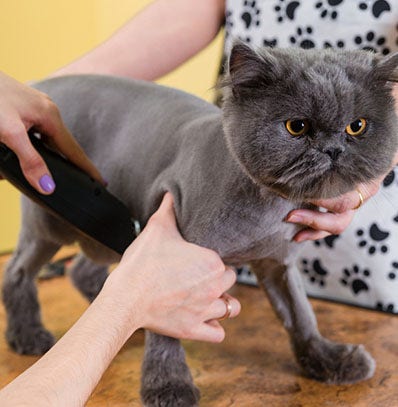
How to Cut Your Cat's Hair
If your cat’s hair is matted, shaving the hair is an option. Matting can be painful and cause scarring to your cat’s skin. There are also other reasons for shaving your cat which include: cat allergies, hairballs, dirty bottoms, and excessive shedding. Not all cats need to be shaved and they can become stressed during the process. Know your feline and what his needs are before shaving.
What you need:
- Pet Clipper
- Brush or comb
Cat Hair Clipping Step-by-Step
-
1
Have a quick play session with your cat to burn off excess energy. Take a few minutes to pet the cat to make sure they are not overly stressed or scared. When your cat is calm, you can start brushing to prep the hair for clipping.
-
2
Thoroughly brush or comb your cat's coat to remove tangles and mats. Once the coat is tangle or mat-free and sleek, you can start clipping away hair.
-
3
Understand the product difference between a pet clipper and a pet trimmer . Wahl clippers are larger tools designed to cut longer body hair. Wahl trimmers are more for detailing and touch-ups.
-
4
Consulting specific breed, size and coat type instructions on this website, use clippers to trim excess fur off the cat’s body, choosing the appropriate clipper guide comb to achieve desired length. Start with the shoulders and progress towards the tail.
-
5
Clip as close to the body as desired, leaving at least a 1/2-inch or more in order to maintain enough protection from the elements.
After the body, move on to clip hair around the paws and tail. Inspect the chest to determine if any trimming is needed. Clip any excess fur that is hanging or isn’t uniform to the rest of the body.
-
6
For final details, clip hair around the paws and tail. Inspect the chest to determine if any trimming is needed. Clip any excess fur that is hanging or isn’t uniform to the rest of the body.
-
7
Clip the head and face last, being careful of moving ears, mouth, eye lashes , whiskers and nose. Choose a clip attachment adhering to your desired fur length. Place the clipper flat against the top of the cat’s head with the blade spokes facing to the rear. Pull the clippers towards the back to push fur away from the upper brow.
-
8
Clip or trim between the eyes by placing the clipper guide comb or the trimmer flat against the forehead with the blade spokes facing the nose. Progress towards the nose, being extra cautious of potential head movement or jerks in order to remain safely away from the eyes.
-
9
Gently wrap your free hand around the cat’s muzzle and point it towards the ceiling. Place the guide comb against the chin, with the spokes facing the throat, and run the clippers towards the throat to trim the underside of the muzzle. Be very careful not to cut your cat’s whiskers when trimming around the muzzle. A cat’s whiskers are necessary for sensing their surroundings and should never be cut.
-
10
Hold the ear tip between fingers so that only fur rests above the fingers (no skin) and trim this hair. Repeat along the edges of the ear. If necessary, gently trim excess hair in the inside of ears, using a smaller trimmer. Always avoid the ear canal.

 India (English)
India (English)
 Middle East and Africa (English)
Middle East and Africa (English)
 South Africa (English)
South Africa (English)
 Australia (English)
Australia (English)
 Japan (日本語)
Japan (日本語)
 South East Asia (English)
South East Asia (English)
 Singapore (English)
Singapore (English)
 Europe (English)
Europe (English)
 France (French)
France (French)
 Germany (German)
Germany (German)
 Hungary (Hungarian)
Hungary (Hungarian)
 Italy (Italian)
Italy (Italian)
 Poland (Polish)
Poland (Polish)
 Portugal (Portuguese)
Portugal (Portuguese)
 Russia (Russian)
Russia (Russian)
 Spain (Español)
Spain (Español)
 The Netherlands (Dutch)
The Netherlands (Dutch)
 Turkey (Turkish)
Turkey (Turkish)
 United Kingdom (English)
United Kingdom (English)
 Argentina (Español)
Argentina (Español)
 Brazil (Portuguese)
Brazil (Portuguese)
 Colombia (Español)
Colombia (Español)
 Latin America (Español)
Latin America (Español)
 México (Español)
México (Español)
 Chile (Español)
Chile (Español)
 Peru (Español)
Peru (Español)
 Canada (English)
Canada (English)



